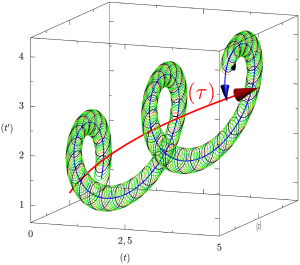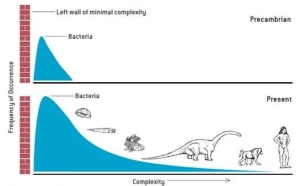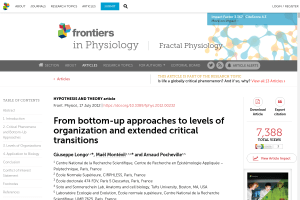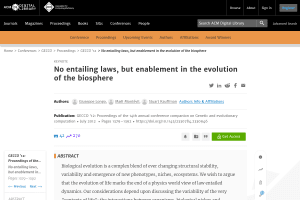
Archives of 2012
-

-
From bottom-up approaches to levels of organization and extended critical transitions
Frontiers in Physiology
Critical phenomena disrupt the mathematical determination at a given level by couplings between scales, leading to a new perspective on levels of organization.
Abstract
Biological thinking is structured by the notion of level of organization. We will show that this notion acquires a precise meaning in critical phenomena: they disrupt, by the appearance of infinite quantities, the mathematical (possibly equational) determination at a given level, when moving at an “higher” one. As a result, their analysis cannot be called genuinely bottom-up, even though it remains upward in a restricted sense. At the same time, criticality and related phenomena are very common in biology. Because of this, we claim that bottom-up approaches are not sufficient, in principle, to capture biological phenomena. In the second part of this paper, following the work of Francis Bailly, we discuss a strong criterium of level transition. The core idea of the criterium is to start from the breaking of the symmetries and determination at a “first” level in order to “move” at the others. If biological phenomena have multiple, sustained levels of organization in this sense, then they should be interpreted as extended critical transitions.
Keywords: bottom-up, extended criticality, levels of organization, organism, renormalization, singularity
Manuscript Citation Publisher Full textCitation
Longo, G., Maël Montévil, and A. Pocheville. 2012. “From Bottom-up Approaches to Levels of Organization and Extended Critical Transitions.” Frontiers in Physiology 3 (232). https://doi.org/10.3389/fphys.2012.00232 -
No entailing laws, but enablement in the evolution of the biosphere
Proceedings of the 14th annual conference companion on genetic and evolutionary computation
The evolution of life marks the end of a physics world view of law entailed dynamics. We discuss the notions of causation and of enablement.
Abstract
Biological evolution is a complex blend of ever changing structural stability, variability and emergence of new phe- notypes, niches, ecosystems. We wish to argue that the evo- lution of life marks the end of a physics world view of law entailed dynamics. Our considerations depend upon dis- cussing the variability of the very ”contexts of life”: the in- teractions between organisms, biological niches and ecosys- tems. These are ever changing, intrinsically indeterminate and even unprestatable: we do not know ahead of time the ”niches” which constitute the boundary conditions on selec- tion. More generally, by the mathematical unprestatability of the ”phase space” (space of possibilities), no laws of mo- tion can be formulated for evolution. We call this radical emergence, from life to life. The purpose of this paper is the integration of variation and diversity in a sound concep- tual frame and situate unpredictability at a novel theoretical level, that of the very phase space.
Our argument will be carried on in close comparisons with physics and the mathematical constructions of phase spaces in that discipline. The role of (theoretical) symmetries as invariant preserving transformations will allow us to under- stand the nature of physical phase spaces and to stress the differences required for a sound biological theoretizing. In this frame, we discuss the novel notion of ”enablement”. Life lives in a web of enablement and radical emergence. This will restrict causal analyses to differential cases (a difference that causes a difference). Mutations or other causal differ- ences will allow us to stress that ”non conservation princi- ples” are at the core of evolution, in contrast to physical dynamics, largely based on conservation principles as sym- metries. Critical transitions, the main locus of symmetry changes in physics, will be discussed, and lead to ”extended criticality” as a conceptual frame for a better understanding of the living state of matter.Keywords: conservation properties, symmetries, biological causality
Manuscript Citation Publisher Full textCitation
Longo, G., Maël Montévil, and S. Kauffman. 2012. “No Entailing Laws, but Enablement in the Evolution of the Biosphere.” In Proceedings of the 14th Annual Conference Companion on Genetic and Evolutionary Computation, GECCO’12, 1379–92. GECCO ’12. New York, NY, USA: GECCO’12; ACM. https://doi.org/10.1145/2330784.2330946 -
The inert vs. The living state of matter: Extended criticality, time geometry, anti-entropy – an overview
Frontiers in Physiology
The physical singularity of life phenomena is analyzed by a comparison with the theories of the inert with a focus on criticality, time, and anti-entropy.
Abstract
The physical singularity of life phenomena is analyzed by means of comparison with the driving concepts of theories of the inert. We outline conceptual analogies, transferals of methodologies and theoretical instruments between physics and biology, in addition to indicating significant differences and sometimes logical dualities. In order to make biological phenomenalities intelligible, we introduce theoretical extensions to certain physical theories. In this synthetic paper, we summarize and propose a unified conceptual framework for the main conclusions drawn from work spanning a book and several articles, quoted throughout.
Keywords: criticality, biological time, anti-entropy, theoretical biology, symmetry, allometry, incompleteness
Manuscript Citation Publisher Full textCitation
Longo, G., and Maël Montévil. 2012. “The Inert vs. The Living State of Matter: Extended Criticality, Time Geometry, Anti-Entropy – an Overview.” Frontiers in Physiology 3 (00039). https://doi.org/10.3389/fphys.2012.00039 -

Géométrie du temps biologique : Rythmes et protension
Questions de phrasé
Nous distinguons les rythmes de type physique de ceux proprement biologiques. Nous abordons aussi les activités protensives et rétensives du vivant.
Abstract
Le vivant possède une phénoménalité particulière et originale. Comme cadre et siège de cette phénoménalité, l’organisation temporelle des organismes est elle-même d’une grande richesse. Ainsi, l’on rencontre dans l’activité biologique des cas de cyclicité : cycle cardiaque, cycle respiratoire, rythmes cérébraux, cycles circadiens, cycle de vie, etc. ; et d’autre part il s’y présente, parfois même au sein de ces cycles, des phénomènes dont la nature semble plutôt être caractérisée par une irréversibilité fondamentale : cognition, nutrition, développement, vieillissement, évolution, ...Il nous semble dès lors impératif, pour aborder théoriquement — et donc aussi empiriquement — ces phénomènes, de les considérer dans un cadre où la question de la temporalité soit abordée de manière adéquate.
Manuscript Citation Publisher Full textCitation
Montévil, Maël. 2012. “Géométrie Du Temps Biologique : Rythmes et Protension.” In Questions de Phrasé, edited by A. bonnet, F. Nicolas, and T. Paul. Editions Hermann. https://www.editions-hermann.fr/livre/9782705681555 -

Randomness increases order in biological evolution: International workshop on theoretical computer science, WTCS 2012, dedicated to cristian s. Calude on the occasion of his 60th birthday, auckland, new zealand, february 21-24, 2012, revised selected and invited papers
Computation, physics and beyond
We revisit the analysis of anti-entropy. In particular, we analyze how randomness stemming from variability leads to the growth of biological organization.
Abstract
In this text, we revisit part of the analysis of anti-entropy in [4] and develop further theoretical reflections. In particular, we analyze how randomness, an essential component of biological variability, is associated to the growth of biological organization, both in ontogenesis and in evolution. This approach, in particular, focuses on the role of global entropy production and provides a tool for a mathematical understanding of some fundamental observations by Gould on the increasing phenotypic complexity along evolution. Lastly, we analyze the situation in terms of theoretical symmetries, in order to further specify the biological meaning of anti-entropy as well as its strong link with randomness.
Keywords: Entropy Production, Biological Evolution, Irreversible Process, Combinatorial Complexity, Biological Organization
Manuscript Citation Publisher Full textCitation
Longo, Giuseppe, and Maël Montévil. 2012. “Randomness Increases Order in Biological Evolution: International Workshop on Theoretical Computer Science, WTCS 2012, Dedicated to Cristian s. Calude on the Occasion of His 60th Birthday, Auckland, New Zealand, February 21-24, 2012, Revised Selected and Invited Papers.” In Computation, Physics and Beyond, edited by Michael J. Dinneen, Bakhadyr Khoussainov, and André Nies, 7160:289–308. Lecture Notes in Computer Science Ser., v. 7160. Berlin, Heidelberg: Springer Berlin / Heidelberg. https://doi.org/10.1007/978-3-642-27654-5_22






